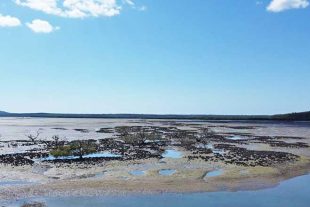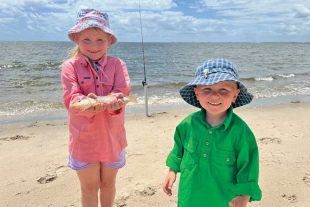When possible, we like to get out to the reefs off Redcliffe.
These shallows provide natural and manmade structures, which open up ambush and protection points frequented by both predatory and bait species.
Gear
Generally, the gear you’ll want will be an upgrade on flathead and bream gear, with the lighter weight and lure range capabilities, as the harsher natural conditions, abrasive terrain and heavier hits can damage lighter reel internals and snap lighter rods.
Pick gear with the appropriate strength and durability to handle the constant stress of the harsher environment.
Read on!
Lure fishing
Like all other lure rods, a soft tip is preferred to allow feel and offer the lure its most natural action.
I find a 7’ or 7.2’ length built on a stiff backbone to provide strength and propulsion in casts and a 2-5kg or 4-8kg weight range is suitable, which helps control the fish and casts.
I’ll pair that with a nice 2500-3000 size reel that includes features allowing it to excel in comfort and enhance performance.
In my opinion, a fast rotor allows you to work basically any lure at any speed, making it the best all-rounder for varying speed, aggressiveness and hops within a retrieve when tempting finnicky fish to bite.
Braid is the most appropriate line to spool your lure fishing reel with, due to its thin round design.
This offers more smooth long casts, which may allow fish more visibility over your mainline, but offers the extra length and accuracy vital to cover more ground to locate fish.
When it comes to braid, there are two types – four strand and eight strand.
Four strand is weaved with thicker strands, giving increased abrasion resistance and offering support when fishing tighter abrasive country.
Eight strand is a thinner round build, is generally thinner coming off the spool and guides a lot smoother, particularly for those situations where you need to cover more reef to potentially bring it past a snapper or grass sweetlip.

Bait fishing
When bait fishing shallower reefs, the technique I use will generally be lightly or unweighted bait left on free spool, so a rod of about 6.6’-7’ and with a long butt to easily fit into a boat rod holder is ideal.
I prefer to use monofilament line that is less visible to fish and has less feel than braid, so a rod with a softer tip will allow for a natural hook set and help detect any small nudges.
You’re spoilt for choice when it comes to reels, so I try to single out baitrunner or more high-end spin or baitcast reels.
Spin reels that are suitable for this style of reef fishing will generally have a fast rotor to suit all retrieves and all lure applications, making it a lot more versatile to help you find what the fish want on the day.
A solid compact reel build will increase durability, enhance performance and give extra reassurance when hooking larger specimens – most reel brands incorporate carbon drag washers above 4000 size.
Thicker and stronger built reels offer more control over fish in tight country.
If I’m trying to isolate those bigger fish around tough reef country, baitcaster reels are more appropriate due to having all the control over casting options, drag setting and other reel settings right at the thumb, making it easier to pick up line and react to hits a lot quicker, so in a nutshell, increasing your reflex speed to prevent fish from rubbing past raspy reef.
Reels with all the right features include Daiwa Tatula, Shimano Tranx and Shimano Curado K 300HG.

Lures
Since sweetlip, snapper and tuskfish can be finnicky though fond of a well-presented live bait, it’s best to match the hatch.
This is a guide to being confident that the lure you pick is going to work.
In clear water, natural bait such as hardyhead, herring, pilchard and yakka give off a sparkle and shine from their silver pattern, so match the hatch with blues, yellows, silvers, whites and pinks to get the better results.
The lures I fish are chosen based on two things – where the bait is schooled and the season.
I generally find it best fishing around the reefs during summer, when the warm water starts to enter the shallow, bringing in different nutrients that in turn usually bring the smaller bait.
The smaller bait available at this time for predatory species include prawns or smaller baitfish, so a grub tail or thinner paddle tail is a deadly and effective choice.
The more subtle but constant action strikes interest from a larger radius, compared to those stronger more dominant vibrations that the bigger paddle tails incorporate, which sometimes shuts down active fish.
An effective retrieve would be a sequence of violent jerks matched with a steady retrieve of a fast-rotor reel and allowing time for the plastic to fall to the bottom, resembling a feeding or vulnerable baitfish, and repeating this – varying up the number of hops, speed of retrieve and time for sink to see what pleases the fish on the day.
Plan B for me would be vibes, due to the versatility, natural profiles and colours available and that you can fish them on any speed and hopping action you like.
Generally, I’ll mark active fish on the sounder and cast up current, allowing my lighter weighted vibe to flutter or vibrate on the fall, while at the same using the current flow to help bring my lure back to vertical, so I’m lifting my vibe through the current instead of having an angle in my line, bringing the lure into the current and lifting my plastic out of the desired depth range.
I then lift and shake the rod tip, causing the lure to flutter or vibrate, acting like a hurt isolated baitfish.

Dirty water
I repeat the same tactics previously explained but change colours from naturals to darks – such as Watermelon, Motor Oil, Midnight Oil, Goldrush and similar – to give off a bolder silhouette, matching the darker tint baitfish have in less water clarity.
I also add scent and give plenty of time on the pauses during the retrieve to let the scent disperse and attract fish from a larger distance.
Jig heads
The jig head size depends on depth, current and wind. So, mix it up and find the best option to suit the conditions.
Go as light as you can get away with, so you’re not bombing the bottom, but maximising how much time the fish get to see it and how natural the lure looks when suspending through bait schools.
Bait
Bait is the most natural option when fishing for reef species that have a flesh bait diet, so here are some recommendations for bait.
In a lot of current and tight country, the most popular bait for fishing would be oily and bloody types – such as pilchard, tuna, yakka, mullet and pike – due to the amount of scent displaced throughout the water column with the aid of the current.
So that your bait can be located by smell, increase the surface area.
Crabs and other crustaceans are located on reefs and generally have a high availability, making them successful, yet finding live fish bait is easier in my opinion.
When fishing live bait through dense abundances of bait varieties, I rig as light as possible under the prevailing weather conditions to have a slow fall and vulnerable appeal, with the injured display involving vibrations and erratic colourations when rigged.
I also like bombing cut bait near the bottom with a heavier lead, to cut through challenging current and wind.
Both of these methods have worked for me with a 10-30lb leader.
I prefer to use fluorocarbon as a staple leader because it is denser than mono and allows your bait presentations to descend through the water column quicker.
In discoloured water after rain, I’ve found that heavier line can reflect a visible tint, which can deter fish and make them feel less comfortable about approaching your offering.
So, ensuring your leader is as light as possible will increase the likelihood of fish striking your bait.

Where to look
Here’s a start on where to locate the reef dwellers.
The saying goes you must find the bait to find the fish, so locate out of current spots when the tide is running – such as holes, pylons, bommies, rock patches.
All patches that allow nutrients and bait to settle are frequent hunting grounds for snapper and sweetlip.
When the tide slackens, look for the depth changes and drift onto edges of reef.
This is often when most bait movement occurs and is therefore likely to be when the more timid rarer species such as tuskfish and red emperor are scavenging the bottom for scraps.
Tide and moon
To finish off, here’s an explanation of which tides and moon phases are most appropriate and effective when chasing the more timid reef fish in shallow water.
When fishing the shallows, its ideal to match a larger tide when more water and bait have access to the shallower regions with the slack high at sunrise and move back 1m of depth every hour, this allows you to move with the tide when the bait is following micronutrients off the shallows into the deeper country, where predatory species are waiting for a feed.
Low light conditions – sunrise, sunset and night – grant those reef dwellers maximum visibility over the bait, making it the most successful time for targeting them, with less boat traffic usually, maximising their time in the shallows without getting spooked.
High tide provides the most water over the reef, maximising the amount of bait and nutrients in your chosen area.
The moon phase I commonly look for with any stage of tide is three days after a new moon – which is known to have the most current – leading to less misplacement of bait and lure presentations.
After the new moon, there’s still more height in the tide, therefore more water is being forced onto the reefs, so more nutrients and bait are holding in the shallow structure.
Also, a couple days after a new moon, the current has less of an effect on fish behaviour and is still in a high solunar activity phase.
High tide is closely followed by a running tide and, due to less reef exposure, more ambush points open up for predatory species to intercept passing bait.
Baitfish movement concentrates past the edges of the reef structure because the bait retreat into deeper cleaner water on the outgoing tide as they follow the micronutrients.
I hope these tips and techniques help to flick the switch when fishing for the timid fish that inhabit shallow areas in Redcliffe and the southeast Queensland region.
Remember the snapper and pearl perch closure from July 15 to August 15.
Tight lines and see you next time.
 Bush ‘n Beach Fishing Magazine Location reports & tips for fishing, boating, camping, kayaking, 4WDing in Queensland and Northern NSW
Bush ‘n Beach Fishing Magazine Location reports & tips for fishing, boating, camping, kayaking, 4WDing in Queensland and Northern NSW









